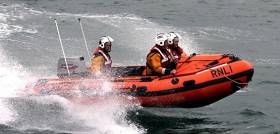Displaying items by tag: Fethard lifeboat
Last week, Fethard RNLI came together to honour and bid farewell to Dr John Cox, who retired from his role as a volunteer Lifeboat Medical Advisor after over 25 years of dedicated service.
Dr Cox began his tenure as a medical advisor in 1996 when Fethard station reopened, taking care of the volunteers and ensuring their regular medical certifications were up to date. Prior to this, he had served for many years at Dun Laoghaire Harbour RNLI station.
During the retirement ceremony, Owen Medland, Area Lifesaving Manager for the southeast, presented Dr Cox with a framed print of Fethard's D-Class Naomh Dubhan on a chart of Ballyteige Bay, which is the station's operational area. Medland praised Dr Cox's voluntary commitment to saving lives at sea and his long-standing dedication to the RNLI. He wished the retiring doctor all the best for the future.
 The Fethard RNLI crew with retiring Medical Advisor Dr John Cox Photo: Sorcha Bird
The Fethard RNLI crew with retiring Medical Advisor Dr John Cox Photo: Sorcha Bird
In response to the presentation, Dr Cox expressed his gratitude, saying, "While Fethard has done a lot for the Lifeboat by providing crews to man our D-Class lifeboat, the Lifeboat has done a lot for our community, not just in the high-profile activities of saving lives at sea but also in providing somewhere where people feel they belong and, most of all, that they feel they are doing something special and are appreciated."
Dr Cox added, "The picture of the Naomh Dubhan with the chart of Ballyteige Bay in the background is quite beautiful and will hang in our hallway for visitors to see for years to come. I wish you all continued success, and now that I do not have to go to work, I will try to take you up on your kind invitation to pop into the station for a cup of tea and a chat some evening."
Fethard RNLI station's management and crew extended their best wishes to Dr Cox and his wife, Mary, as they began the next chapter of their lives. Dr Cox's service and dedication to the RNLI will undoubtedly be missed, but his legacy will continue to inspire and guide volunteers for years to come.
Fethard RNLI has assisted two people onboard a pleasure craft which got into difficulty off the Wexford coast this afternoon (Sunday 15 May).
The volunteer crew launched their inshore lifeboat at 3.40pm following a request from Waterford River Rescue which reported that a 21ft Bayliner pleasure craft with two people onboard had got into difficulty.
The vessel had sustained engine failure at Creadan Head, some three miles upriver from Dunmore East.
The D Class lifeboat helmed by Thomas Stafford launched at Duncannon and made its way to the scene.
Weather conditions at the time were described as good with a fresh south westerly on shore breeze.
A local fishing vessel aided the operation by providing the lifeboat crew with the exact location of where the pleasure craft was.
Once on scene, the lifeboat crew observed that no one was in any immediate danger and began to establish a tow line.
Fethard RNLI proceeded to bring the vessel one mile up stream where the crew then handed the tow over to Waterford River Rescue who brought the vessel safely back to Waterford.
Speaking following the call out, Thomas Walter, Fethard RNLI Helm said: ‘Today’s call out was an example of good team working between ourselves and our colleagues in Waterford River Rescue. We were delighted to assist and wish the two sailors well.’
Memorial and Exhibition to Mark Centenary of “Mexico” Disaster
#FethardLifeboat- For over than three decades the Trustees of the Lifeboat Memorial in The Burrow, Rosslare, Co. Wexford have laid a wreath in memory of those who lost their lives at sea.
This year marks the 100th anniversary of the "Mexico" disaster in which the monument commemorates. During this heroic rescue nine lifeboat men from the Fethard lifeboat and one crew member from the Norwegian schooner "Mexico" lost their lives.
To commemorate the centenary of the disaster, the trustees are laying a wreath at The Burrow on Sunday 23 February at 3pm.
As part of the event, a photographic and memorabilia exhibition in association with the Rosslare Maritime Enthusiasts, will highlight the rescue of the "Mexico" and that of a 'fort' settlement, which disappeared into the sea in 1920's. The exhibition will be held in Scoil Mhuire National School, Rosslare on the weekend of Saturday 22 February, (12noon and 7pm) and Sunday 23 February (10am and 5pm).
All are welcome. For further information contact Billy Doyle on 086 6386002, Des Peare on 087 6827497 or John Boyce on 086 393425 email: [email protected]
Night in Igloo Raises funds for the RNLI
Brothers Rory (37) and Eoin (36) O'Connor spent last night (Thursday 2 December 2010) in an igloo on Duncannon beach in county Wexford to raise funds for RNLI lifeboats. The pair went into the home-made igloo at 8pm last night and emerged this morning at 8am.
The igloo was built on Duncannon beach by local men Patrick Byrne and David Walsh following plummeting temperature and heavy snowfall in the southeast. On hearing of the structure, Rory and Eoin approached the men to ask if they could spend a night in the igloo to raise funds for RNLI lifeboats. With their agreement they made plans to spend the evening in the ice and brought with them special clothing and sleeping bags to brave the arctic temperatures.
Rory is a volunteer lifeboat helm on Fethard-on-Sea D class inshore lifeboat in county Wexford and when the temperatures dropped on the south-east coast he and his brother Eoin decided to do something to raise funds for the RNLI and to remind people that lifeboat crew go out in all types of weather.
Speaking from the igloo at the end of their night Fethard lifeboat helm Rory said "We are honestly delighted with the response from the public to our sleepover. People were dropping by the igloo all night to say hello and drop some money in the bucket. We even had a local pub send down some hot whiskeys to keep us warm. It was actually quite comfortable and we even managed to get a good night's sleep."
The brothers emerged this morning in good spirits and were looking forward to a cooked Irish breakfast on the beach.
Rory and Eoin have set up a donations page HERE. The brothers have so far raised over €1,500 for the lifeboats.

A night in the cold has produced 1500 Euros so far!






























































